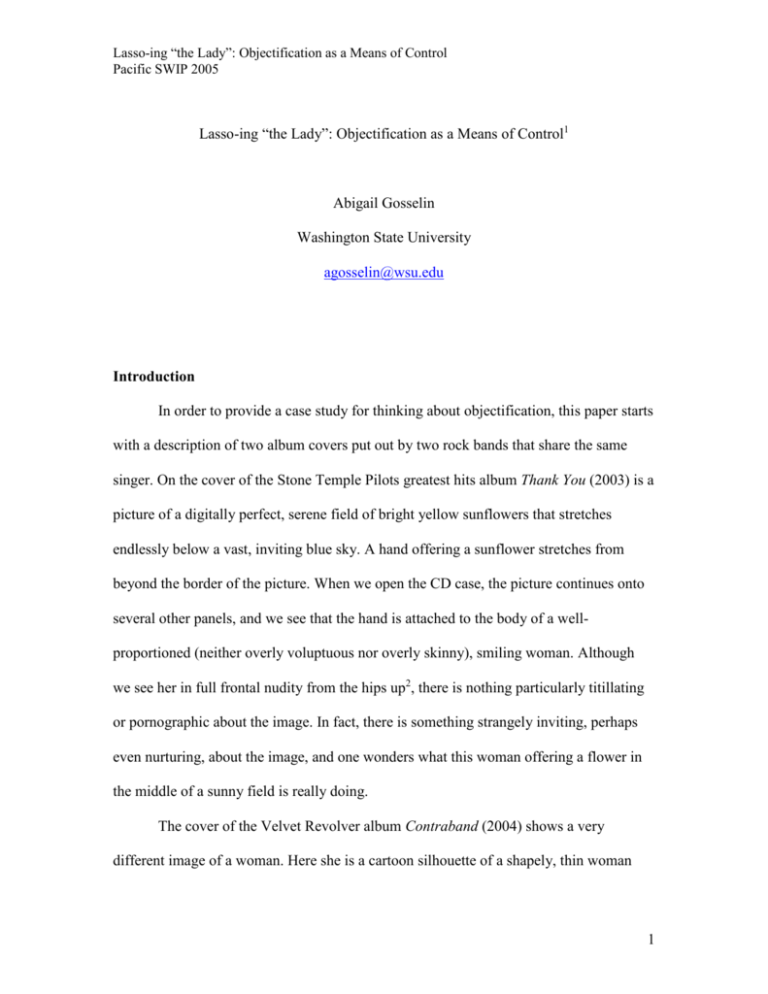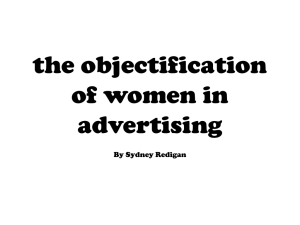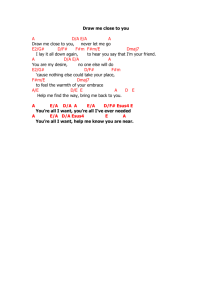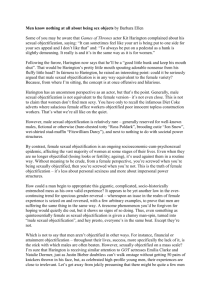Lasso-ing “the Lady”: Objectification as Means for Control
advertisement

Lasso-ing “the Lady”: Objectification as a Means of Control Pacific SWIP 2005 Lasso-ing “the Lady”: Objectification as a Means of Control1 Abigail Gosselin Washington State University agosselin@wsu.edu Introduction In order to provide a case study for thinking about objectification, this paper starts with a description of two album covers put out by two rock bands that share the same singer. On the cover of the Stone Temple Pilots greatest hits album Thank You (2003) is a picture of a digitally perfect, serene field of bright yellow sunflowers that stretches endlessly below a vast, inviting blue sky. A hand offering a sunflower stretches from beyond the border of the picture. When we open the CD case, the picture continues onto several other panels, and we see that the hand is attached to the body of a wellproportioned (neither overly voluptuous nor overly skinny), smiling woman. Although we see her in full frontal nudity from the hips up2, there is nothing particularly titillating or pornographic about the image. In fact, there is something strangely inviting, perhaps even nurturing, about the image, and one wonders what this woman offering a flower in the middle of a sunny field is really doing. The cover of the Velvet Revolver album Contraband (2004) shows a very different image of a woman. Here she is a cartoon silhouette of a shapely, thin woman 1 Lasso-ing “the Lady”: Objectification as a Means of Control Pacific SWIP 2005 with very smooth lines, seemingly dressed in leather, wearing high heeled stiletto boots. She carries a gun, and in different parts of the CD case and the CD itself the gun is held at different positions, sometimes in its holster on her hip as she reaches for it, other times pointing out from her hand, in one place pointing squarely at the viewer. Although here we only see her outline, this woman is more obviously sexy and alluring than the one above—and clearly more dangerous. In addition to propagating visual images such as these, the singer and lyricist of both bands, Scott Weiland, has made throughout his career numerous, varied references to women in his lyrics, some of which are just as sensationalistic as these images. Objectification of women is so common in rock music that it is a cliché, and for feminists it is very easy to condemn images such as the two above as negative stereotypes, the preponderance of which harms women. I do not necessarily disagree, but I do think there is something deeper going on in these images than what we initially see, something that should complicate the judgments that we make as feminists. If we look beyond the sensationalism in such examples of objectification, we find that at least in some cases objectification is doing some serious work in how people—both men and women—relate not only to other people but also to themselves. Objectification serves a purpose that is not always and necessarily harmful; in some ways and at least sometimes it can be a helpful tool. Objectification Objectification involves treating a thing that is not properly an object, or is more than an object, as if it is merely or essentially an object, as a thing whose essence is material reality. We generally use the term objectification to refer to the treatment of a 2 Lasso-ing “the Lady”: Objectification as a Means of Control Pacific SWIP 2005 person as an object, for a person normally contrasts with an object, insofar as a person is more properly a subject.3 The objectification of a person involves denying the elements of her subjectivity and treating her as if she is merely a body. Objectification is functional; it serves a purpose. The reason why people objectify things is to have control over them, for turning a thing into an object allows one to manipulate it, and so do what one wishes to it. The thing that is usually objectified is what one wishes to have control over, in other words what is seemingly out of one’s control for some reason. Understanding objectification requires understanding the nature of this control, and the reasons why the thing one wishes to control are seemingly out of one’s reach. It is far beyond the scope of this paper to explain and defend my understanding of control, but I define the term as: securing the ends at which one aims. In other words, there are different mental activities that have as their nature the aiming at ends, which some philosophers call “pro-attitudes.”4 Desiring, wishing, and intending are examples of these pro-attitudes, for all of these involve a thing that is aimed at, an end of their activity. When a person desires, wishes, or intends, she desires, wishes, or intends some thing, some object, some end.5 Control is the ability to guarantee that that end will be attained, to guarantee the satisfaction of one’s desire, wish, or intention (or other proattitude). Thus control is securing the object or end of one’s aim. Because control is an activity involving some elements of freedom, willing, and agency (far beyond the scope of this paper to address in any detail), it is an ability that only subjects are capable of possessing.6 Objects cannot control anything, even themselves, for they do not have the capacity to act with intention; they do not have pro- 3 Lasso-ing “the Lady”: Objectification as a Means of Control Pacific SWIP 2005 attitudes and so cannot aim their actions for some purpose. Yet, as means that can be used for some end, they are the kinds of things that can be controlled or manipulated to secure some desired end. Thus, subjects have the potential capacity to control, and objects are the things that can be controlled. Treating a person as an object potentially denies her subjectivity. As Linda Lemoncheck points out, treating a person as a thing is not objectionable when she consents to this treatment; in such cases, we treat her as an end, valuing her consent, as well as a means. What is morally problematic about objectification is when it does not involve consent, such as resulting from coercion or exploitation, thus treating her as a means only.7 This treatment is dehumanizing because it transforms the kind of value a person has from intrinsic to extrinsic, depending on the use to which we put her, as an object serving some functional purpose. Objectification without consent is a way to have control over a person. It removes the aspects that constitute her subjectivity and dignity, including her freedom and agency, denying her capacities to reason, to act intentionally, to be responsible. Objectification denies that a person has these capacities by forbidding her to exercise them, or by not recognizing them as such when she does. Instead, she is simply an object, reduced to her material form as merely a body. She is something that can be used and manipulated by others, subject to their will and intention, for whatever purpose they desire. Objectification essentially makes her a non-person. Personification In order to explain what role objectification is playing in the images described above, we need to look at the role played by its opposite, personification. While objectification treats people as objects, personification treats objects as people. In other 4 Lasso-ing “the Lady”: Objectification as a Means of Control Pacific SWIP 2005 words, personification treats things that are not truly persons as if they have certain characteristics of personhood. Which characteristics are assumed depends on the particular instance of personification, and the purpose that it serves. When objects are personified, they are frequently referred to by gendered pronouns, as “she” or “he,” which are references that we normally reserve for persons or at least for living things, rather than “it,” which is the reference we normally use with respect to inanimate objects. If Scott Weiland is employing personification in his lyrics, then his gendered pronouns refer not to actual women or men, but rather to objects that are personified, i.e. that take on characteristics of persons. Using gendered pronouns to refer to these objects merely becomes shorthand for referring to the object itself. If this is the case, then women serve as a metaphor, standing in for some other object. The questions I consider in the next section are what objects are being personified in his lyrics, and which characteristics of personhood are the relevant ones that he is treating these objects as having. I suggest that what is being personified, what Weiland is really singing about, and what those images of women really represent, is relationships of desire. What Weiland really would like to control by personifying it as a woman and then objectifying “her” are elements of his drug addictions and bipolar disorder.8 Before turning to this discussion, however, I would like to consider whether objectification of an idea or image of a woman is harmful. Certainly such images may be offensive, but offense is not a harm.9 If what is being objectified is the personification of a thing—so that the image of a woman is objectified even though the woman is merely a metaphor for desire and drugs, and no specific woman is being actually and directly harmed —then it is unclear who, if anyone, is being harmed, or how. Yet the perpetuation 5 Lasso-ing “the Lady”: Objectification as a Means of Control Pacific SWIP 2005 of such imagery does harm women, by enforcing negative stereotypes and expectations that lead to various harmful consequences for women. Even if they do not involve the direct treatment of actual women, such images exist within and contribute to a cultural context in which women are routinely perceived and treated in specific ways that harm them, especially in ways that are violent (such as rape, harassment, and other kinds of aggression), often resulting in violence that women inflict upon themselves (such as eating disorders or self-mutilating behaviors that are inflicted in shame or selfpunishment).10 Thus there are real harms that result from the perpetuation of sensationalistic, stereotypic images of women. I want to point out here that I fully acknowledge this harm, even as I also want to complicate our evaluation of objectification, such as in Scott Weiland’s use of it, in order to admit its potentially coexisting benefits. Desire The idea that rock music is largely about desire or drugs is nothing earthshattering or new. Weiland would not be the first lyricist to personify drugs as women, nor is it only men who do this; witness Stevie Nicks’ “Gold Dust Woman,” a song in which the “gold dust woman” represents cocaine. I suspect there is a long tradition in rock music of using the metaphor of women and romantic relationships to represent drugs and their appeal and destructiveness. Nevertheless, I examine Weiland’s use of objectification in order to provide a jumping-off point, so to speak, for a philosophical analysis that explores relationships between desire, control, and methods by which we seek control. What this exploration would give us, ultimately, is an understanding of what aspects of desire are the relevant ones regarding control, including the contexts when 6 Lasso-ing “the Lady”: Objectification as a Means of Control Pacific SWIP 2005 desire makes us feel out of control and the reasons for and the means by which we seek control over our desires. The rest of this paper develops only a part of this larger project, namely why and how objectification and personification serve as a means for this control. Weiland personifies as female several aspects of desire relationships, including both desire itself—i.e. the act of desiring—and the object or end of desire—i.e. what it is that is desired. Insofar as “woman” represents drugs and drug use, she is both desire itself and the object of desire—whether this is the thing that promises to provide a good experience, i.e. heroin, or whether it is the good experience itself, i.e. the pure sublimity Weiland wishes to experience through the use of heroin. In his lyrics, “she” is a “woman,” a “Sunday girl” (who will get him to “heaven”), a “bitch,” a “princess,” a “whore,” a “lady,” the “Mexican princess,” a “Hollywood bitch,” an “incessant bitch,” a “ready teller whore,” and a “superhuman woman,” with all the connotations these phrases imply. In these embodiments, “she” refers to at least four aspects of desire: desire itself, the satisfaction of desire (the desired experience), the thing that promises this satisfaction (heroin or other drugs), or sometimes even Weiland himself. In various ways these four aspects of desire relationships become conflated with each other.11 For Weiland, women typically represent the object or end of desire, such as either heroin or the experience that heroin promises to deliver. On one hand, their desirability makes them inviting, perhaps even seem warm and nurturing. The woman on the cover of the Stone Temple Pilots CD, Thank You, offers a flower that promises sublimity, and this makes her desirable in a glowing, inviting way. I do not think it is a stretch to suggest that the woman represents drugs like heroin that promise experiences of serenity, peace, and tranquility.12 On the other hand, the desirability of the objects that women represent 7 Lasso-ing “the Lady”: Objectification as a Means of Control Pacific SWIP 2005 makes them sexy, and when the attainment of them, or even the pursuit of them, is harmful, they are also dangerous. This is what the image of the alluring woman holding a gun on the cover of the Velvet Revolver CD, Contraband, represents: the sexy and dangerous nature of all those things that count as contraband, especially drugs. Yet women also represent the source or originator of desire, in other words, the thing that desires. Women are needy and dependent; when a person, even a man, like Scott Weiland enters strong relationships of desire (such as addiction), he puts himself in the feminine position of the desiring self. This position of need and dependence contrasts with his view of “the man,” whom he sees as a provider who is not himself needy, as autonomous rather than dependent, as unencumbered by desire and temptation. In contrast to “the woman,” who is dependent on others for fulfillment of her desires and therefore for completion of her selfhood, “the man” is capable of taking responsibility for himself and being a responsible, autonomous agent.13 Failing to be a man is failing to recover and move on. I imagine Weiland admonishing himself when he reaches the depths of despair, desiring a fix or being tempted by suicide, to “be a man,” in other words to take responsibility. Yet being a man is a precarious situation, for Weiland loses this status when he pursues his desire, when he falls back victim to his addiction. In his most recent lyrics, written after his last major rehabilitation, he wonders how long this state of being a man will last. Weiland writes of “the woman”—desire and its object—as a romantic partner, which is why his lyrics seem sometimes to be about a lover. This is not unusual in rock music, of course. But his lover is not a real person—in fact, a real person (or at least an image of one as only rock lyrics can construct) is only symbolic of his real lover. His real 8 Lasso-ing “the Lady”: Objectification as a Means of Control Pacific SWIP 2005 lover is heroin and what she promises. And so, mid-career14, he has lyrics about waiting for his date who stands him up, and he cries out desperately that he hopes this is only a break (from heroin), not the breakup (not the final recovery), and he cries out his love in a primal scream of agony. This is the despair of intense desire that goes unfulfilled, and the utter lack of control one feels in being unable to satisfy it.15 He has songs about dating heroin, breaking up, chasing her, desperately begging her, being made a fool of by her as she taunts him with false promises. She also pursues him as desire keeps nagging at him—she is incessant and insatiable. She can never be satisfied, yet she won’t let him go any more than he will let her go. She is insistent and everywhere, ever present. As he sees her everywhere he is obsessed with her; she becomes everything, and she promises to solve all his problems. She is not just an answer; she is the answer to everything. She subsumes every thing that exists in his experience until she finally subsumes him and his identity as well. In this transference of identity, where she becomes he and he becomes she, a person obliterates his sense of self and loses his identity in the overwhelming presence of desire and its incessant, insatiable, obsessive demands. In the ultimate act of transference and personification, Weiland—an oversexed heterosexual who is very comfortable with his sexuality, by his own account— also sometimes dresses as a woman in stage performance. He does not just chase woman as desire and its object; he becomes a woman, or at least the image of a woman. He becomes what he desires. In some lines Weiland says clearly that a woman is not a man—that if a person is victim to desire then he cannot be a responsible agent. But in other lines he suggests they are equivalent. This is probably because of the confusion that desire brings about, in the 9 Lasso-ing “the Lady”: Objectification as a Means of Control Pacific SWIP 2005 promises that desire makes but cannot fulfill. It promises to solve one’s problems—make him a new man, for instance—but in fact it does not and cannot. It lies, and this gender confusion reflects that lie—and Weiland’s belief in the lie, at least in the moment. Confusion of gender represents confusion within desire and the confused, irrational mindset of the person ensnared in the cycle of pursuing desire. Control Objects of desire are frequently confused. A person thinks he desires one thing, but actually he desires another. Or he thinks this thing will fulfill his needs, but actually it will not—and this other thing will. The most striking transference of identity that occurs is when the object of desire is confused with one’s self: when he becomes it, when his self is subsumed by desire. For Weiland, heroin seems to fill needs that he may not be able to identify properly, such as needs to be loved or to be reassured that he is okay. As it appears to fill these needs, to provide answers, it seems to complete him—in fact, it takes the place of these needs. The self with needs becomes transposed with the object that completes the self by fulfilling needs and providing answers. As a result, the self is eliminated entirely. This is why recovery from misplaced, confused desire—such as occurs in both drug addiction and eating disorders—may require personification and objectification of the desire: in order to separate out the object and its desire from the self once again. For example, people recovering from eating disorders often write letters saying goodbye to their eating disorders, which they have personified, often as “Ann” or “Ed.”16 Or Weiland writes about fighting “the lady,” now separated from himself, as he attempts to become 10 Lasso-ing “the Lady”: Objectification as a Means of Control Pacific SWIP 2005 “a man.”17 Personification and objectification allow and actually enforce this separation between self and object, serving as powerfully transformative rhetorical tools. These tools are therapeutically useful for recovering from harmful behaviors other than drug abuse, of course. For example, anorexia is often said to be about “control,” and the relationship between appetites regarding food and more general appetites of desiring and wanting is no accident. In a larger project I want to examine what is the nature of this control that anorexics seek, and I suspect that it is the same kind of thing that drug users seek: to control their subjective experiences, the ways they feel and the ways they relate to the world—and consequently to control their various desires.18 Desire over which one seems not to have can be excruciatingly painful. To the extent that disordered eaters or drug abusers lack control over the form and content of their desires, they commonly confuse the objects of what they desire and identify too closely with elements of this desire—seeing themselves as essentially “an anorexic” or “a heroin addict,” and seeing their lives as revolving exclusively around these identities and their accompanying desires and behaviors. When this identification occurs, methods that separate the object (heroin or anorexia, for instance) from the subject (the person with the harmful behavior) are necessary to regain a sense of self. Personification of the behavior or the object (substance or illness) that it concerns and objectification of that “person” separates the thing from the self and turns it into an object capable of manipulation. Interestingly, the personification of desire that occurs in eating disorders is often gendered, just as it is in drug use.19 Early anorexia authority Hilde Bruch claimed that the voice of the demanding, punitive “dictator” that tells the anorexic that she must perform the behaviors associated with her illness is male. This is the negative voice that the 11 Lasso-ing “the Lady”: Objectification as a Means of Control Pacific SWIP 2005 anorexic “hears” admonishing her that she is not good enough, and telling her to do better. I suspect that the more “positively” experienced voice that the anorexic “hears” that encourages her to engage with the “anorexic lifestyle” is experienced as either female or as androgynous.20 Of course, if this encouraging voice is female, it would be a very different representation of femininity than the desiring self that the anorexic wishes to deny. In her compulsive attempt to control her desire, the anorexic tries to eliminate neediness and dependence from her identity altogether—literally, starving the feminine aspect of her self to death.21 The voice that encourages her “positively” (rather than punitively) in this pursuit probably would not be experienced as masculine because it is not aggressive, or is it positioned in opposition to her own gendered body, but rather in concert with it. Denying elements of both femininity and masculinity, this voice takes on the form of a gendered identity somewhere between the two extremes, perhaps some ideal of androgyny that eliminates the most undesirable traits of both genders. As the latter example suggests, personification of one’s behaviors, desires, and their objects does not necessarily serve a positive therapeutic purpose; such personification may also merely perpetuate such harmful behaviors. The danger of objectifying oneself—such as in the way an anorexic may objectify herself in viewing her body so critically and detachedly—is alienation of the self.22 Since objectification of the self involves separating out the person from the essential aspects of her personhood— making her essentially a body, a thing with merely material reality—estrangement may result.23 Nevertheless, the same method that a person uses to perpetuate her behavior— such as personifying it—can also be used, especially within therapeutic settings, to fight it. Since the anorexic already knows she has the power to use this method in one way, she 12 Lasso-ing “the Lady”: Objectification as a Means of Control Pacific SWIP 2005 can easily learn how to use the same method in a different context, providing her greater means for control—this time over her recovery. The therapeutic value of personification and objectification must therefore be evaluated according to its particular context. In some contexts, objectification of the self can actually be liberating, especially when it involves playing with gender and its associated symbolism and characteristics. Self-objectification can only be liberating, however, when it involves treating the self as an object but also as an end in itself, never as a means only. In this use of objectification, representations of gender as expressed through the body enrich and transform one’s selfidentity, so that objectification uses the body as a means, but for the sake of valuing and enabling growth within the self as a whole. For example, Weiland’s objectification of himself separates himself from his desire, and the aspect of this that plays with gender involves seeing himself as both desiring and not-desiring, as both the responsible autonomous man and the needy woman capable of sublime experiences. Through both his physical appearance and stage performance, he intentionally tries to cultivate specific presentations of his body, especially gendered representations. As he became skinnier over the past fifteen years (presumably at least partly the result of drug use and addiction), he correspondingly adopted a more androgynously and sometimes blatantly “feminine” appearance. He adorned more makeup, styled and dyed his hair in provocative ways, and wore flashy, tight clothes onstage and for publicity, and sometimes even dresses. This intentional cultivation is no doubt inspired by his hero David Bowie’s glam persona, and perhaps it is also a way for him to bridge the divide between what he saw the two genders as representing: the needy, desiring woman who is also the sexy and dangerous object of desire, and the independent man who is a 13 Lasso-ing “the Lady”: Objectification as a Means of Control Pacific SWIP 2005 responsible agent providing for others. For him androgyny may be an intentional dialectic between two ways of being, between desire and object, between emotional sensitivity and self-control, between needing and providing, between freedom and responsibility. Objectifying the body by playing with gender meanings and norms can also be a powerfully liberating tool for anorexics and others who are trapped by a conception of rigidly gendered relationships of desire, enabling them to have more effective control over their desires than do their functional yet self-destructive behaviors. Feminist theorists note that although the anorexic seeks control over her desires and behaviors, anorexia cruelly mocks this goal by making her the object of its control, so to speak, since her desires and behaviors control her. Any behavior that requires rigid conformity to an ideal difficult or impossible to attain—whether anorexic obsession-compulsion or drug addiction (or the addiction of other behaviors such as bulimia or compulsive eating)—reduces the ability a person has to secure the object of her aims (i.e. to have control). True control over desires that involve gender traits and identity thus involves transformation of, rather than rigid conformity to, gender meanings and norms. Conclusion An earlier version of this paper was titled “Is Scott Weiland a Sexist Pig?” What I found philosophically interesting about Weiland’s use of objectification is that a survey of his entire body of music made it very clear that he was using objectification as a tool. I wondered if such use was compatible with feminist principles, or if any depiction that objectifies women is necessarily sexist. The more I thought about this project, however, the more I realized that whether Weiland is sexist is philosophically irrelevant. The real question is, “Why does Scott Weiland objectify women the way he does, in other words 14 Lasso-ing “the Lady”: Objectification as a Means of Control Pacific SWIP 2005 what purpose does it serve?” As I began to understand the personally valuable, therapeutic purpose it served for him, I realized that people recovering from other harmful behaviors, especially eating disorders, do very similar activities that serve similar purposes. These purposes are not necessarily incompatible with feminist principles; in fact, feminism can endorse the use of tools like objectification and personification in certain circumstances, especially in contexts that question mainstream gender norms. After all, if the personal really is political, then political change often requires personal transformation as well. This does not mean that imagery such as Weiland’s is not offensive or harmful to women, of course. As indicated above, I fully acknowledge the way that imagery that perpetuates negative or at least limiting stereotypes about women contributes to a cultural context of harm and violence (whether other- or self-inflicted). What this examination is meant to do, however, is to show that normative evaluations of uses of rhetorical tools like personification and objectification is more complicated than may initially appear. 1 Please note that this paper is a work-in-progress. Some of the information in the endnotes is actually in the body of the text of the longer version of this paper; for the sake of conference readability, I tried to separate out the elements that were less necessary in making my general argument. 2 While the field of sunflowers appears entirely digitally produced in its hyper-realistic perfection, a model was used for the photograph of the woman. Presumably the photograph was touched up to eliminate blemishes, but it is to some extent a “real” image. 3 Things other than subjects may be objectified, however, especially things that do not have as their basic essence material reality, things such as intellectual ideas or subjective experiences and mental states (feelings, dispositions, etc.). 4 For example, see Ishtiyaque Haji, Moral Appraisability: Puzzles, Proposals, and Perplexities, New York and Oxford: Oxford University Press, 1998, p. 108; R. Jay Wallace, “Addiction as Defect of the Will: Some Philosophical Reflections,” Law and Philosophy 18 (1999): 621-654, especially pp. 630-631. 5 Note that “object” here takes on a different meaning than that implied by the concept of objectification; instead of being a physical thing, an object here is a goal or end of one’s aim, which may or may not have material reality. Yet the securing of this end, and the attainment of this object, is the essence of control. The linguistic connection between object as material thing and object as end of aiming suggests a relationship between turning things into material objects and securing one’s ends, further suggesting the nature of objectification as concerning control. 15 Lasso-ing “the Lady”: Objectification as a Means of Control Pacific SWIP 2005 6 Philosophically speaking, a subject is what Kant called an end in itself, containing within itself its own purpose for existence and action, whereas an object is a means to an end, something that can be used for some other purpose. Subjects are persons, possessing dignity or intrinsic value. A subject derives its intrinsic value from its capacity for reason, and consequently for agency, autonomy, and freedom. A subject is thus active: it is the seat of reasoning, experience, choices, and action. In contrast, an object has only extrinsic worth, deriving value from what use others (namely subjects) can find for it. An object is potentially functional, able to serve purposes that subjects design or designate for it. An object is thus passive: things are done to it; it can be manipulated or controlled depending on the use to which it is put— but it does not do things in the active sense that a subject does things; it does not manipulate or control its own existence or function, never mind that of anything else. N.B.: Let us not get confused about the different uses of related words. Although persons are subjects, having subjectivity, they also have objective rather than subjective ends, at least on Kant’s account. This means that persons (subjects) have universal, objective value, rather than contingent, relative (or subjective) value—which, confusingly, is the value possessed by objects, those things that have a price and can be used as means only. For more on Kant’s distinction between ends and means, see Immanuel Kant, Grounding for the Metaphysics of Morals, Trans. James W. Ellington, Indianapolis: Hackett, 1993, pp. 35-36 (sections 427-428). 7 Lemoncheck, Linda, “What’s Wrong with Being a Sex Object?” in Living with Contradictions: Controversies in Feminist Social Ethics, Ed. Alison M. Jaggar; Boulder: Westview Press, 1994, pp. 199206. 8 Weiland’s battles with cocaine and heroin addictions have been highly publicized over the past ten years, beginning with his 1996 arrest for possession and the year-long imprisonment that followed. He has also been arrested several other times, including for charges related to domestic battery and driving under the influence, and he has made many rehabilitation attempts. He suffers from bipolar disorder, and the relationship between this mood disorder, his drug addictions, and other (self-) destructive behaviors is a fascinating and pertinent one to the issues of desire, control, and the methods by which people attempt to attain control, but are far beyond the scope of the present paper to address. For more information on Weiland’s biography, an Internet search can provide numerous news articles, briefs, and interviews. A selection of relevant articles and interviews is listed as follows: “Bill Maher Discusses Addiction is a Choice by Jeffrey A. Schaler, Ph.D.,” with guests including Dr. Drew Pinsky and singer Scott Weiland; transcript of the show Politically Incorrect with Bill Maher on March 13, 2000; website http://www.schaler.net/addictionisachoice/PItranscript.htm, accessed 3/4/2005. Weiland—and Pinsky—talk about how drug use results from nearly uncontrollable desire, that addiction has a physical component over which free will has little or no reign. Edwards, Gavin, “Revolver Loaded,” Rolling Stone, June 16, 2004; website http://www.rollingstone.com/news/story/_/id/6185031/scottweiland?pageid=rs.Artistcage...; accessed 12/4/04. Includes interviews with Velvet Revolver bandmates; Weiland talks about his behaviors surrounding drugs, as well as the suicidal depressions that both contributed to and resulted from his drug use. Elfman, Doug, “Closer to the Edge,” Neon, December 31, 2004; website http://www.reviewjournal.com/lvrj_home/2004/Dec-31-Fri-2004/weekly/25517307.html; accessed 1/29/05; interview with Scott Weiland about his bipolar disorder and addictions. Elliott, Paul, “The Boys are Back in Town,” Mojo, December 2004, 88-92. Interviews with Velvet Revolver band members, including Scott Weiland, who talks about his bipolar disorder and drug addictions. Oliveiro, Melanie, “Velvet Revolver: Interview with Scott Weiland,” July 8, 2004; website http://64.233.167.104/search?q=chache:RXKe_XZmQNAJ:www.newsradio.com.sg/ssi/ente...”; accessed 1/29/05. Among other topics, Weiland talks about his sexuality and his selfdestructiveness. “Scott Weiland Speaks Out,” WholeNote: The On-Line Guitar Community, August 2, 2001; website http://www.wholenote.com/news/item.asp?i=489; accessed 5/1/2005. Interview with Scott Weiland, who talks about his bipolar disorder and creativity, among other topics. “Stone Temple Pilots” biography, Answers.com; website http://www.ansers.com/topic/stone-temple.pilots; accessed 5/1/05. 16 Lasso-ing “the Lady”: Objectification as a Means of Control Pacific SWIP 2005 Varga, George, “Q&A with Velvet Revolver,” San Diego Union-Tribune, March 24, 2005; website http://entertainment.signonsandiego/com/profile/274471/?p=1; accessed 5/1/05. Interviews with Velvet Revolver band members, including Scott Weiland, who talks candidly about his internal demons. “Velvet Revolver—Drugs! Booze! Kung Fu! GN’R!” Classic Rock 72, November 2004; website http://www.heretodaygonetohell.com/articles/showarticle.php?articleid=135; accessed 5/1/05. Interviews with Velvet Revolver band members, including Scott Weiland. Weiland, Scott, “The Devil Gives You the First Time for Free: A Biography of My Addiction,” as told to Mike Sager, Esquire, April 2005, 132-137 and 156-157. 9 Feinberg, Joel, Harmless Wrongdoing (The Moral Limits of the Criminal Law, Volume 4), New York: Oxford University Press, 1988. 10 For more on the culturally harmful aspect of objectification of women in media, advertising, and other public images, see Jean Kilbourne, Can’t Buy My Love: How Advertising Changes the Way We Think and Feel, New York: Touchstone (Simon & Schuster), 1999, especially pp. 278-279. 11 Specific lyrics that provide support for the claims I make can be given upon request; providing the textual evidence in this paper would constitute several papers in itself. 12 “Serenity, tranquility, and peace” is a drug reference referring mainly to the psychedelic drug DOM, which is a synthetic amphetamine derivative related to Ecstasy (MDMA); it is also often called “STP.” But these three words also describe an experience that many drugs, including hallucinogens and opiates, promise to deliver. Note that the band name “Stone Temple Pilots” is commonly abbreviated as “STP”; in fact, the band called itself several other names, all with the initials “STP,” before deciding on their final name, suggesting that the particular words chosen were more or less random and that only their initials mattered. For more on the drug STP, see Andrew Parrott, Alum Morinan, Mark Moss, and Andrew Scholey, Understanding Drugs and Behavior, Hoboken, NJ and West Sussex: John Wiley & Sons, Ltd., 2004, p. 82. 13 Associating these traits with their respective genders is of course stereotypical and potentially harmful, as such stereotypes limit our views of what women and men can or should be. Nonetheless such association is popularly assumed and frequently internalized. Ann Ferguson gives the following list of comparable gender traits, which I believe could resonate with Weiland: Men are thought to be more active, independent, aggressive, self-interested, competent at physical activity, rational, emotionally controlled, and selfdisciplined; in contrast, women are thought to be more passive, dependent, non-assertive, altruistic, not competent at physical activity, intuitive, emotionally open, and impulsive (46). Ferguson, Ann, “Androgyny as an Ideal for Human Development,” in Feminism and Philosophy, Eds. Mary VetterlingBraggin, Frederick A. Elliston, and Jane English, Totowa NJ: Littleifled, Adams & Co., 1977, pp. 45-69. Note that the last three traits of femininity—“intuitive, emotionally open, and impulsive—are also traits of the emotional sensitivity that accompanies mood disorders like bipolar disorder. Weiland’s own emotional sensitivity as resulting from his bipolar disorder probably predisposes him to identify with femininity in certain ways, which he sometimes whole-heartedly endorses (as I shall explain), and other times to which he reacts in extremely masculine ways (such as with aggression towards women and femininity) in response. The tensions he has regarding gender reflect the conflicts he has over appreciating his own emotional sensitivity and desire, and the creativity and openness they foster, yet also wanting to have control over both with some form of self-containment and mastery. 14 These lyrics mainly come from the two albums he made following his year-long arrest and rehabilitation, in 1998 and 1999 respectively. 15 For more on addiction as a relationship, see Kilbourne, pp. 234-250. 16 This has become standard therapeutic practice in recovery from eating disorders. A friend of mine showed me her own such goodbye letter, and it was very powerful. See Irvine, Martha, “Cult-Like Lure of ‘Ana’ Attracts Anorexics,” on-line at CNN Netscape News, May 30, 2005. Website http://cnn.netscape.cnn.com/ns/news/story.jsp?idq=?ff/story/0001%2F20050530%2F131346... Accessed 6/2/05. 17 Examples of this therapeutic use of personifying desire as a woman and then objectifying her abound in Weiland’s lyrics. Through this personification and objectification, he can label his desire, describe its effect on him, and react to it (such as in anger); this provides a way for him to try to control his desire and fight his addiction. The title of this paper, for instance, refers to a lyric in the Velvet Revolver song, “Superhuman,” which expresses Weiland’s internal conflict about both wanting and fighting the desire for 17 Lasso-ing “the Lady”: Objectification as a Means of Control Pacific SWIP 2005 drugs, in terms of controlling a woman: “We’re all runnin from the goose she’s high on cocaine/There’s a noose swimming right between her legs to her brain/We’re all in need of a superhuman woman now/We’re all in need of a superhuman woman now/So rodeo, rodeo, rodeo, rodeo/Throw the rope around her neck and get the show on the road.” 18 I acknowledge that eating disorders and drug addictions are not perfectly analogous to each other, particularly as the former involves a substance that one cannot live without, i.e. food, and the latter involves a substance foreign and harmful (at least in large doses) to the body. Nonetheless, they are closely related, both methods by which a person attempts to control her experiences, and both inextricably tied to desire. Some theorists suggest that the purpose of the anorexic’s rigid self-control is to achieve sublimity or salvation, akin to the “hunger artists” and “fasting girls” of the 19 th century. Sublimity and salvation are heightened idealistic experiences, or “highs,” that drug abusers frequently seek as well. We commonly assume that these experiences are sought through different means—that anorexics seek salvation and sublimity through domination of the will, and that drug users seek “serenity, peace, and tranquility” through changes in brain chemistry. These differences may only be cosmetic, however, pertaining to our descriptions of the events but not to the actual metaphysics involved. A psychiatric perspective of anorexia may likely describe the anorexic pursuit in similar biochemical terms as the drug pursuit, while a philosophical or psychological perspective may describe drug use as exercising willful control over attaining desired experiences. For an analysis of anorexia for the sake of salvation, see Michelle Mary Lelwica, Starving for Salvation: The Spiritual Dimensions of Eating Problems among American Girls and Women, New York: Oxford University Press, 1999. For an account of anorexia as pursuit of sublimity, see Sheila Lintott, “Sublime Hunger: A Consideration of Eating Disorders Beyond Beauty,” Hypatia: A Journal of Feminist Philosophy 18:4 (Fall/Winter 2003), pp. 65-86. Joan Brumberg explains the phenomenon of “fasting girls” in Fasting Girls: A History of Anorexia Nervosa, New York: Plume (Penguin), 1989. 19 In my discussion I am assuming anorexics that are female, as it is estimated that 90% of all anorexics are. (See the Diagnostic and Statistical Manual or Mental Disorders, Fourth Edition, Washington DC: American Psychiatric Association, 1994, p. 543.) Other eating disorders may be analyzed in similar gendered accounts, as bulimics and compulsive eaters (especially females) probably also interpret selfadmonishment as male and encouragement as female or androgynous. The gendered aspects of male anorexia and other eating disorders would also be interesting to explore. 20 For more on the pursuit of the “anorexic lifestyle,” see Carol Martin, “Anorexia Battle Undone Online: ‘Pro-Ana’ Websites Offer Support Groups Countering Treatment,” Denver Post, July 17, 2001, pp. 1A and 13A; also Irvine, “Cult-Like Lure of ‘Ana’ Attracts Anorexia.” For more philosophical analysis on the nature of desire and control in anorexia, see Susan Bordo, “Anorexia Nervosa: Psychopathology as the Crystallization of Culture,” in Unbearable Weight: Feminism, Western Culture, and the Body, Berkeley: University of California Press, 1993, pp. 139-164. Hilde Bruch’s observations are in her book, The Golden Cage: The Enigma of Anorexia Nervosa, New York: Vintage (Random House), 1978 (cited in Bordo, p. 155). 21 See Bordo, p. 160. 22 See Sandra Bartky, “Narcissism, Feminity, and Alienation,” in Femininity and Domination: Studies in the Phenomenology of Oppression, New York: Routledge, 1990, pp. 33-44; also Abigail Gosselin, “Consuming Goods, Consuming Foods: Alienation, Consumption, and Disordered Eating,” Discourse: An Interdisciplinary Journal of Philosophy 9 (Spring 2003), pp. 53-70., pp. 53-69. 23 Sandra Bartky, “On Psychological Oppression,” in Femininity and Domination: Studies in the Phenomenology of Oppression, New York and London: Routledge, 1990, pp. 22-32. 18








